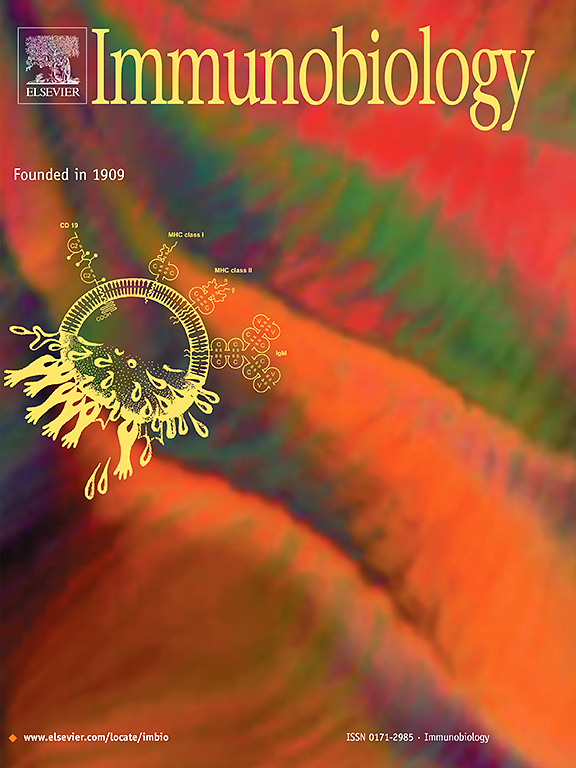Giardia duodenalis triggered neutrophil extracellular traps in goats
IF 2.3
4区 医学
Q3 IMMUNOLOGY
引用次数: 0
Abstract
Giardia duodenalis is a globally distributed zoonotic parasite primarily transmitted through the fecal-oral route, infecting various vertebrates, and the infection of which is prevalent in goats. Immune cells play a crucial role in pathogens invasion, and neutrophil extracellular traps (NETs) released by neutrophils serve as a non-specific defense mechanism against pathogens including parasites. In this study, we investigated the characteristics, components, and molecular mechanisms of goat NETs upon stimulation with G. duodenalis trophozoites. This study demonstrates that G. duodenalis trigger dose-dependent NETs formation in goat neutrophils, composed of DNA, citrullinated histone H3 (CitH3), and neutrophil elastase (NE). Reactive oxygen species (ROS) accumulation synchronizes with NETosis during G. duodenalis infection. Inhibitor experiments confirmed that G. duodenalis-induced NETs and ROS production depend on TLR2/4 signaling and require NADPH oxidase (NOX), ERK1/2, and p38 MAPK activation. This work identifies TLR2/4, NOX, ERK1/2, and p38 MAPK pathways as key regulators of NETs/ROS coordination during G. duodenalis infection, providing the first evidence of G. duodenalis-triggered NETs in goats. The findings highlight NETs as critical components of anti-G. duodenalis immunity and suggest potential for NETs-targeted therapeutic strategies.
十二指肠贾第鞭毛虫引发山羊中性粒细胞胞外诱捕
十二指肠贾第虫(Giardia duodenalis)是一种分布于全球的人畜共患寄生虫,主要通过粪-口途径传播,感染多种脊椎动物,在山羊中很普遍。免疫细胞在病原体入侵过程中起着至关重要的作用,而中性粒细胞释放的中性粒细胞胞外捕获物(NET)则是抵抗包括寄生虫在内的病原体的一种非特异性防御机制。在本研究中,我们研究了山羊滋养体刺激中性粒细胞胞外捕获器的特征、成分和分子机制。本研究表明,十二指肠蛆虫会触发山羊中性粒细胞形成剂量依赖性的NETs,NETs由DNA、瓜氨酸组蛋白H3(CitH3)和中性粒细胞弹性蛋白酶(NE)组成。在十二指肠球菌感染期间,活性氧(ROS)的积累与NETosis同步。抑制剂实验证实,十二指肠球菌诱导的NET和ROS生成依赖于TLR2/4信号,并需要NADPH氧化酶(NOX)、ERK1/2和p38 MAPK激活。这项研究确定了 TLR2/4、NOX、ERK1/2 和 p38 MAPK 通路是十二指肠杆菌感染期间 NETs/ROS 协调的关键调节因子,首次提供了十二指肠杆菌触发山羊 NETs 的证据。这些发现突出表明,NET 是抗十二指肠球虫免疫的关键组成部分,并为以 NET 为靶点的治疗策略提供了可能性。
本文章由计算机程序翻译,如有差异,请以英文原文为准。
求助全文
约1分钟内获得全文
求助全文
来源期刊

Immunobiology
医学-免疫学
CiteScore
5.00
自引率
3.60%
发文量
108
审稿时长
55 days
期刊介绍:
Immunobiology is a peer-reviewed journal that publishes highly innovative research approaches for a wide range of immunological subjects, including
• Innate Immunity,
• Adaptive Immunity,
• Complement Biology,
• Macrophage and Dendritic Cell Biology,
• Parasite Immunology,
• Tumour Immunology,
• Clinical Immunology,
• Immunogenetics,
• Immunotherapy and
• Immunopathology of infectious, allergic and autoimmune disease.
 求助内容:
求助内容: 应助结果提醒方式:
应助结果提醒方式:


